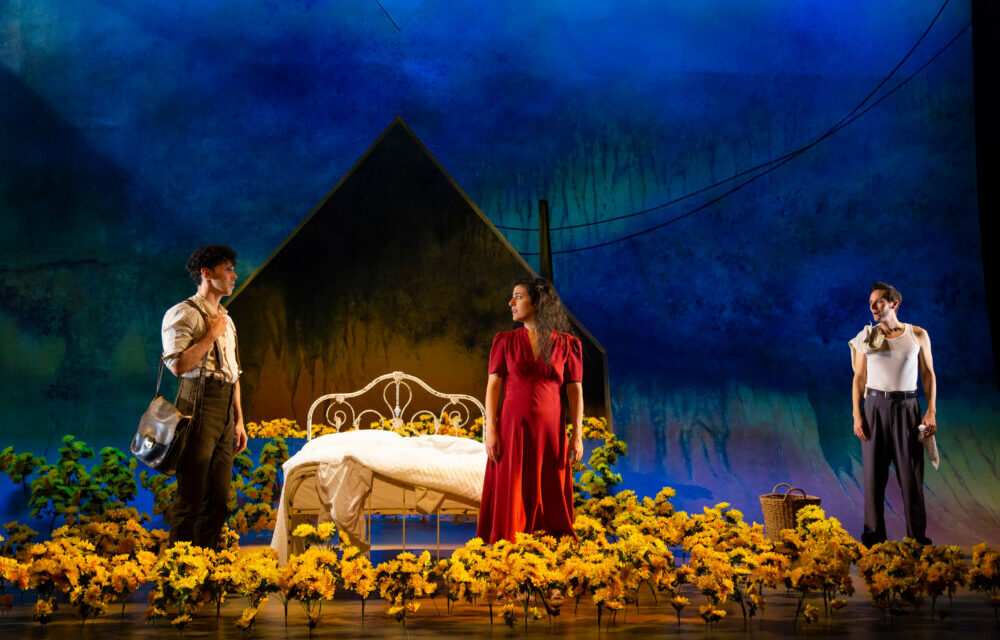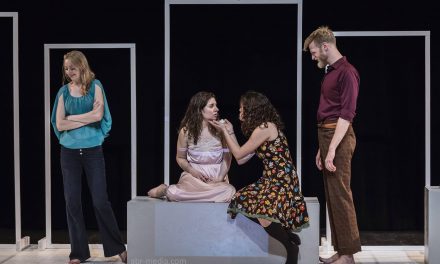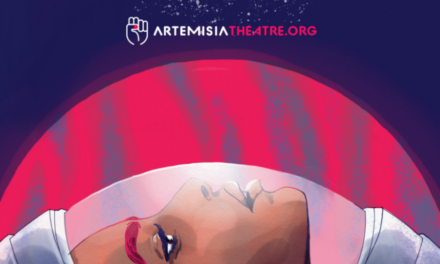Yerma, the titular character of Federico García Lorca’s play is terribly desperate. She desperately wants a child, desperately desires admittance into the prescript markers of womanhood, and desperately wants the freedom to live a life of love. But the heavens thwart her every desire, and she, like the characters in the many Greek tragedies before her, pushes against the gates of fate to a disastrous end. Playwright and performer Melinda Lopez translates and adapts Lorca’s tragedy for a 21st-century English-speaking audience in the new production at the Boston’s Huntington Theatre Company, directed by Melia Bensussen. Lopez creates literal musicality from Lorca’s lyrical poetry and adapts the rural Spanish landscape into a timeless, familiar, and seemingly American landscape. In many ways, this translaptation—a term coined by playwright David Ives—adeptly expresses the beauty and brutal heartbreak of Lorca’s text. But translation is a tricky business and adaptation even more so, and despite many clever touches by Lopez, specific dramaturgical choices create hurdles that this play struggles to overcome.
If, as Russian philosopher Mikhail Bakhtin says about language is that it is, “not a neutral medium that passes freely and easily into the private property of the speaker’s intentions; it is populated – overpopulated – with the intentions of others”, then translation itself must be overpopulation to the extreme—bursting at the seams with intentions, cultural constructions, time, and a myriad of other tricky populations. It is difficult to wrench a work from its original language and place it within a new context, divorced of the cultural assumptions buried in language. Lorca’s poetic language complicates this even further. In the program, Melinda Lopez says that she endeavored to make the play, “feel it’s being spoken by the characters in the moment, while at the same time maintaining that magic of the world.” Rather than outright translating the poetry, Lopez finds a musical modality different than that found in the work’s original poetry. In this production, two instrumentalists underscore poetic passages, turning some of the language into gorgeous and often haunting musical work. The characters continue to speak with honeyed tongues to one another, to mixed success. In the performance I attended, Nadine Malouf, playing the title character, began by conveying the language unevenly—sometimes motivating the words, other times unclear if she believed her own character’s poetic passion. Her husband Juan, played by Christian Barillas, employed a natural rhythm that helped balance their interactions. A few minutes into the piece, Nadine found her own stride and carried the music and the prose admirably. Equally successful in this translaptation is that Melinda Lopez is not hamstringing the language to Lorca’s own poetry but has effectively created lyrics all her own, which do not read as displacing Lorca’s words but augmenting it.
Another compelling augmentation is the symbolic underpinnings of the work. Cameron Anderson’s scenic design fills the stage with dandelions, encompassing a spare bed robed in white sheets. A silhouette of a house sits behind the bed, cut out into a wall with a little utilized playing space. The stage is set as a literal place of bounty, of earth fertile with dandelions—a plant regarded by many as a weed to root out. Yet, here the characters gather the dandelions through the play’s proceedings, laying them in baskets as if they are a precious yield. As the characters uproot the many flowers, the bountiful earth becomes barren. Bounty and barren: the two enduring symbols of Lorca and Lopez’s work. Yerma’s desire for a child among a fertile land and people is sometimes critically read as her desire to bloom alongside nature; that motherhood is as natural to womanhood as dandelions are the fruit of the earth. But Lorca and Lopez clearly speak of rocks, thorns, and sand also as nature’s bounty—less recognized or valued but also necessary to the ecology—a sentiment echoed in Plato’s Menexenus, “in fertility and generation, woman does not set an example to the earth, but the earth sets an example to woman.”
Another central symbol in Lorca’s original text is the binary of light and darkness. Lorca’s Yerma is split, with the first half of the play intended to indicate the daylight, where all is revealed, life is moving unabated, and workers are sweating in the fields. The second half is the darkness, where secrets are whispered, candles are lit, and the men may come home, or in Juan’s case, stay out in the fields under the stars. It is no wonder then, that Lorca places much of the spiritualism in the latter dark half of the play. Yerma visits a witch, prays alongside a Catholic pilgrimage, and then the town explodes into a pagan festival, all as night settles in this rural landscape. Despite the light and dark structure built into the text, the direction and dramaturgy of Lopez’s production didn’t always buoy this symbolism. A sense of inevitable doom and frenzy seemed to be missing in the latter half this production. Melinda Lopez mostly cuts down the pagan festival, with only a few nods towards its existence on the fringes of the stage action, and, instead of a pagan fertility dance with a masked man and woman present in Lorca’s text, Lopez has added a scene that plays like a dream, where Victor—her true love—arrives shirtless with a bull’s head. It is a nod towards the dark desperation and eroticism of paganism, sanitized in this production as a dream.
The reduction of Lorca’s depictions of paganism is an example of one of this translaptation’s biggest weaknesses: the expression of cultural specificity, or lack thereof. When Lorca wrote Yerma, he was obsessed with the lives of people in rural Spain. Later, some referred to Yerma and Lorca’s other more famous works, The House of Bernardo Alba, and Blood Wedding, as his “Rural Trilogy.” The language, ritual, and work of the people became the fodder for his fictions in this and his other rural plays. Melinda Lopez, however, described her imagined landscape and the characters that populate this production:
I thought about the Central Valley in California, especially because there is a very large Latinx community of farmers working there and I wanted to keep that sense of connection to the Spanish language. But a lot of the play also feels like Vermont; it could really be anywhere in this country where water is precious and where people work closely with the land.
This lack of specificity—this “anywhere”—plays into a dramaturgical flaw more often constructed by white/non-Latinx playwrights: that Spanish language/accents and maybe Catholicism is enough to define a Latinx character. Obviously, Latinx people are altogether too varied and rich in their countries of origin, their tongues, rituals, and even their form of Catholicism for such pat stereotypes. For example, my Latinx identity is framed by my culture in New Mexico, which has its own complicated expression of latinidad, with a mix of Mexican and Pueblo Indigenous identity, which is much different than, say Puerto Rican, Cuban, or Spanish latinidad.
In this production, characters spoke in numerous Latinx accents, which altogether isn’t too distracting for anyone living in metropolitan cities like Boston, where such a variety of Latinx identities intermingle. However, workers in many rural agrarian communities don’t usually express such variety as widely. It wouldn’t be uncommon, for instance, for the majority of Latinx workers in the Central Valley of California or Vermont to be from Mexico. A 2011-2012 U.S. Department of Labor’s National Agricultural Workers Survey indicated that 71% of all farm workers were immigrants and of them, 95% were from Mexico. That would mean in the Central Valley of California and in Vermont, the pagan rituals would probably look closer to the works of a Mexican curandera over the brujerías found in the Caribbean Latinx countries. Accents would be different and the cultural and political frame would certainly be more legible.
Inevitably, the lack of cultural specificity impacted the legibility of this work, adding to a vagueness already present in many new adaptations of Yerma—a vagueness that comes from the distance between now and the work’s original time period, Lorca’s lush poetry, and from the confusing unending desire of Yerma for a child—a desire so fervent that some young women in the audience at the Huntington’s production told me later that Yerma seemed written by a man who hated or at least didn’t understand women. I don’t feel that way, but I can understand that impulse, which comes with such a thematic and cultural distance. Not clarifying what landscape we’re working within, what people we are working with, and, thereby the socio-political dynamics that fuels the pressure for motherhood, the world of this translaptation of Yerma loses the relevance and universality that actually comes with cultural specificity.
I left the production wishing for a version that clearly placed the work in California’s Central Valley, where a Mexican family worked to cultivate the fruit of the land, pressured by the politics of migration to the United States and raising a family here, forced to see a curandera to magic fertility, all while the impending water crises in California gnaws at the fringes of their bounty. Or also a version in Vermont, with a defined time period—something to help this devastating story take root.
In all, Melinda Lopez has taken on a huge task and the work is most successful and hauntingly beautiful, thanks to the strong cast, the gorgeous design choices, and Melia Bensussen’s clear direction. Further dramaturgical clarity and specificity would certainly take the work further. And such specificity would only serve to buoy the narrative by giving the play roots in a specific landscape, culture, and tongue—which is just enough earth to make the poetry unfurl in all its beauty.
This post was written by the author in their personal capacity.The opinions expressed in this article are the author’s own and do not reflect the view of The Theatre Times, their staff or collaborators.
This post was written by James Montaño.
The views expressed here belong to the author and do not necessarily reflect our views and opinions.


















